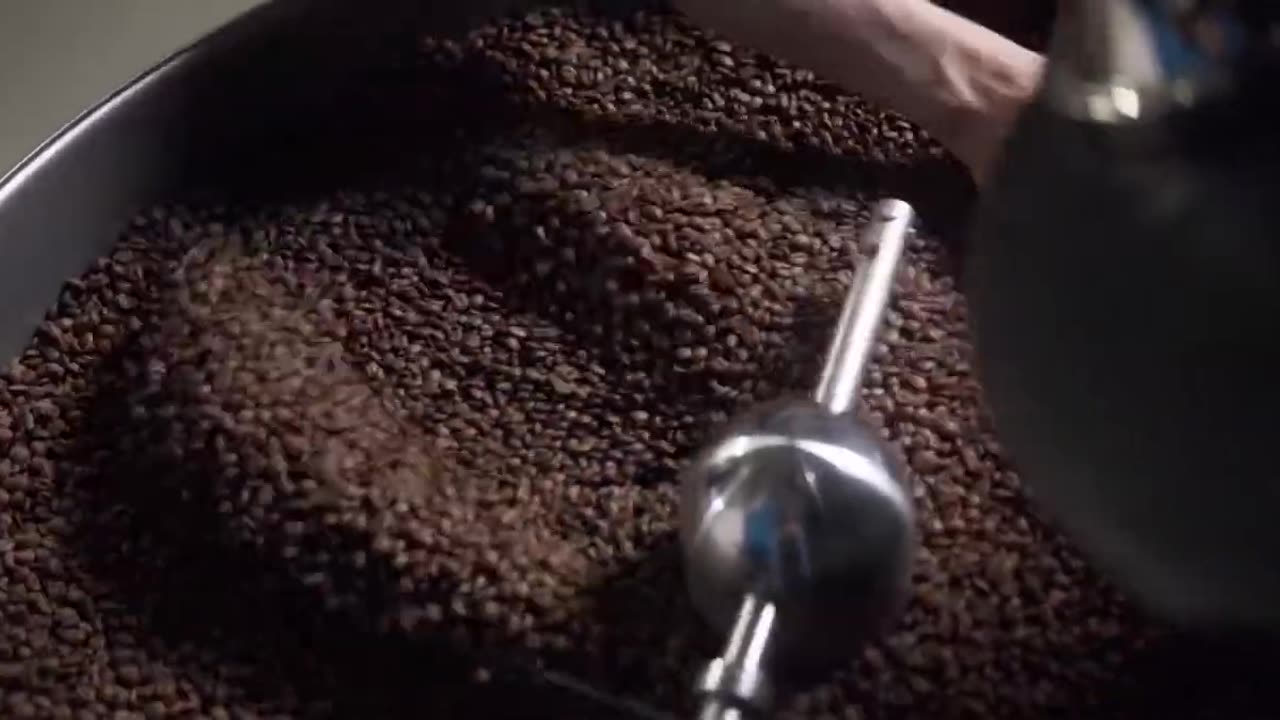Premium Only Content

Coffee Bean Roasting Process
The process of coffee production: from seed to cup
Coffee is one of the most beloved beverages worldwide. Part of its appeal has been attributed to the fact that coffee has a higher caffeine content than most naturally produced beverages, such as tea and cocoa. In this article we will look at the process of coffee production from seed to your cup.
Planting
Coffee beans are actually seeds. It’s only after they have been dried, roasted and ground that they can be used to brew the humble zip. If unprocessed coffee seeds are planted, they can germinate and grow into coffee plants.
Harvesting
Depending on the specific variety, it takes approximately 3-4 years for newly planted coffee bushes to bear fruit. The fruit, commonly termed cherries, depending on the degree of ripeness, turn from green to bright or dark red – the unripe ones being green in colour. Cherries ripen faster under lower altitudes and higher temperatures. Coffee can be hand-harvested by people to ensure that only the ripe cherries are picked.
Strip picking – The cherries are stripped off of the branch, either by hand or by machine
Selective picking – The red cherries are picked and the green ones are left to ripen. Picking is carried out at 10 day intervals. Since this method is labour intensive, it is mainly used to harvest the high quality Arabica coffee.
Cherry processing
After harvesting, cherries are processed as soon as possible to avoid spoilage. Depending on available resources and location, one of the following two methods is used.
The dry method
This is the ancient method of processing cherries and is still popular in regions where water is scarce. This method is also known as ‘unwashed’ or ‘natural’ processing.
The wet method
This method is a relatively new way of removing the skin from coffee cherries. It’s called ‘wet’ because it uses water to both move the coffee fruit through the process and to extract the beans.
Coffee milling process
Before being taken to the market, the dried coffee beans are processed as follows: Hulling: Hulling parchment coffee involves removing the dried husk; exocarp, mesocarp and endocarp. Polishing:
Coffee tasting process
The packed coffee is repeatedly tasted to additionally check and define its taste and quality. The process is called capping and it takes place in a special room designed to enhance it.
Acidity: Acidity describes the level of acidity of coffee. High acidity coffee is thought to be of a higher quality. Low acidity coffee is usually called soar
Coffee roasting
Unroasted coffee is also known as green coffee and such beans have all the flavours locked in them. Roasting seeks to transform the green coffee into the aromatic brown beans you buy in your favourite stores. Roasting is carried out at temperatures of approximately 550F during which time the green coffee beans are turned continuously to avoid burning. Green beans are first dried until they become yellow and develop roasting smell. Once the beans register an internal temperature of 400F, the step called ‘first crack’ happens during which the beans double in size and start to turn light brown. After that, as the temperature continues to rise, the colour changes to medium brown and a fragrant oil (caffeol) starts to emerge.
This roasting stage is called pyrolysis and is the heart of roasting. It gives coffee the aroma and flavour that you witness every time you drink this magical drink. At this stage, coffee is light or medium roasted and roasting process can be stopped or continued to obtain a darker roast. After first crack and first pyrolysis, beans are absorbing heat until they reach an internal temperature of around 440F, at which point the ‘second crack’ happens and the second pyrolysis begins. Beans turn from medium dark to dark brown and you can see an oily sheen. Once roasting is complete the beans are usually doused in huge amounts of water to cool them off instantly. Becoming an expert roaster takes years of training and experience. A good roaster has to know his beans and equipment. Roasting involves being able to accurately predict the internal temperature of individual beans: something that cannot be taught; it can only be learned from years of experience.
Conclusion
Coffee processing is a very human-intensive process. It requires a lot of expertise to make the right cup of coffee. Thus, one should not dismiss branded coffee.
•
•
•
☕️ #coffee #cafe #instacoffee #toptags #coffeetime #cafelife #caffeine #coffeebreak #coffeefirst #coffeeshopvibes #butfirstcoffee #coffeeaddict #coffeegram #coffeeoftheday #ilovecoffee #coffeelover #coffeelovers #coffeecup #coffeeholic #coffiecup #coffeelove #coffeefliicks #coffeeholic #coffeelife #coffeeplease #ig_coffee #thehappynow #kopi
-
 LIVE
LIVE
LFA TV
18 hours agoLFA TV CHRISTMAS EVE REPLAY
873 watching -
 4:33:48
4:33:48
tacetmort3m
1 day ago🔴 LIVE - THE ZONE KEEPS PULLING ME BACK - STALKER 2 - PART 15
44.3K12 -
 22:45
22:45
Brewzle
14 hours agoI Went Drinking In A Real Bourbon Castle
29.4K3 -
 48:36
48:36
PMG
1 day ago $2.16 earned"Parkland Parent Speaks Out On Kamala Harris Using Victims"
22.4K3 -
 4:06
4:06
The Lou Holtz Show
13 hours agoCoach Lou Holtz’s Heartfelt Christmas Message 🎄 | Family, Faith & Notre Dame Spirit 💚 #christmas
16.8K -
![ROSEANNE BARR - Her Journey, TRUMP, and the MAGA GOLDEN AGE! [INTERVIEW]](https://1a-1791.com/video/s8/1/M/m/B/2/MmB2v.0kob.1-small-ROSEANNE-BARR-Her-Journey-T.jpg) 51:35
51:35
Dr Steve Turley
1 day ago $18.37 earnedROSEANNE BARR - Her Journey, TRUMP, and the MAGA GOLDEN AGE! [INTERVIEW]
52.1K51 -
 57:38
57:38
The Tom Renz Show
11 hours agoMerry Christmas - The Tom Renz Show Christmas
89.6K17 -
 2:59:10
2:59:10
Wendy Bell Radio
22 hours agoThe Bridge Too Far
167K301 -
 1:03:45
1:03:45
Donald Trump Jr.
1 day agoHappy Festivus: Airing Our Grievances and Stopping The Swamp w/Sean Davis | TRIGGERED Ep.201
427K546 -
 1:30:30
1:30:30
Game On!
1 day ago $7.99 earnedTop 5 things you need to know for Sports Christmas!
74.7K5